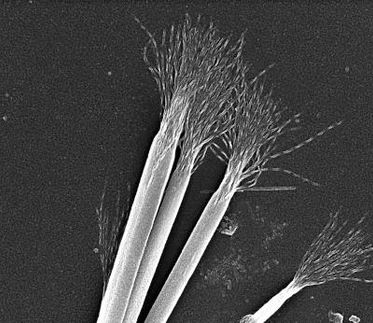Molecular trick alters rules of attraction for non-magnetic metals
Scientists have demonstrated for the first time how to generate magnetism in metals that aren't naturally magnetic, which could end our reliance on some rare and toxic elements currently used.
In a study led by the University of Leeds and published today in the journal Nature, researchers detail a way of altering the quantum interactions of matter in order to "fiddle the numbers" in a mathematical equation that determines whether elements are magnetic, called the Stoner Criterion.
Co-lead author Fatma Al Ma'Mari, from the School of Physics & Astronomy at the University of Leeds, said: "Being able to generate magnetism in materials that are not naturally magnetic opens new paths to devices that use abundant and hazardless elements, such as carbon and copper."
Yet, despite their widespread use, at room temperature only three elements are ferromagnetic - meaning they have high susceptibility to becoming and remaining magnetic in the absence of a field, as opposed to paramagnetic substances, which are only weakly attracted to the poles of a magnet and do not retain any magnetism on their own. These ferromagnetic elements are the metals iron, cobalt and nickel.
The condition that determines whether a substance is ferromagnetic is called the Stoner Criterion. It explains why iron is ferromagnetic while manganese is not, even though the elements are found side-by-side in the periodic table.
The Stoner Criterion was formulated by Professor Edmund Clifton Stoner, a theoretical physicist who worked at the University of Leeds from the 1930s until the 60s. At its heart, it analyses the distribution of electrons in an atom and the strength of the interaction between them. It states that for an element to be ferromagnetic, when you multiply the number of different states that electrons are allowed to occupy in orbitals around the nucleus of an atom - called the Density of States (DOS) - by something called the 'exchange interaction', the result must be greater than one. The exchange interaction refers to the magnetic interaction between electrons within an atom, which is determined by the orientation of each electron's magnetic 'spin' - a quantum mechanical property to describe the intrinsic angular momentum carried by elementary particles, with only two options, either 'up' or 'down'.
In the new study, the researchers have shown how to change the exchange interaction and DOS in non-magnetic materials by removing some electrons using an interface coated with a thin layer of the carbon molecule C60, which is also called a 'buckyball'.
The movement of electrons between the metal and the molecules allows the non-magnetic material to overcome the Stoner Criterion.
Dr Oscar Cespedes, principal investigator of the project, also from the University's School of Physics & Astronomy, said: "We and other researchers had noticed that creating a molecular interface changed how magnets behave. For us, the next step was to test if molecules could also be used to bring magnetic ordering into non-magnetic metals."
Most read news
Organizations
Other news from the department science

Get the chemical industry in your inbox
By submitting this form you agree that LUMITOS AG will send you the newsletter(s) selected above by email. Your data will not be passed on to third parties. Your data will be stored and processed in accordance with our data protection regulations. LUMITOS may contact you by email for the purpose of advertising or market and opinion surveys. You can revoke your consent at any time without giving reasons to LUMITOS AG, Ernst-Augustin-Str. 2, 12489 Berlin, Germany or by e-mail at revoke@lumitos.com with effect for the future. In addition, each email contains a link to unsubscribe from the corresponding newsletter.




























































